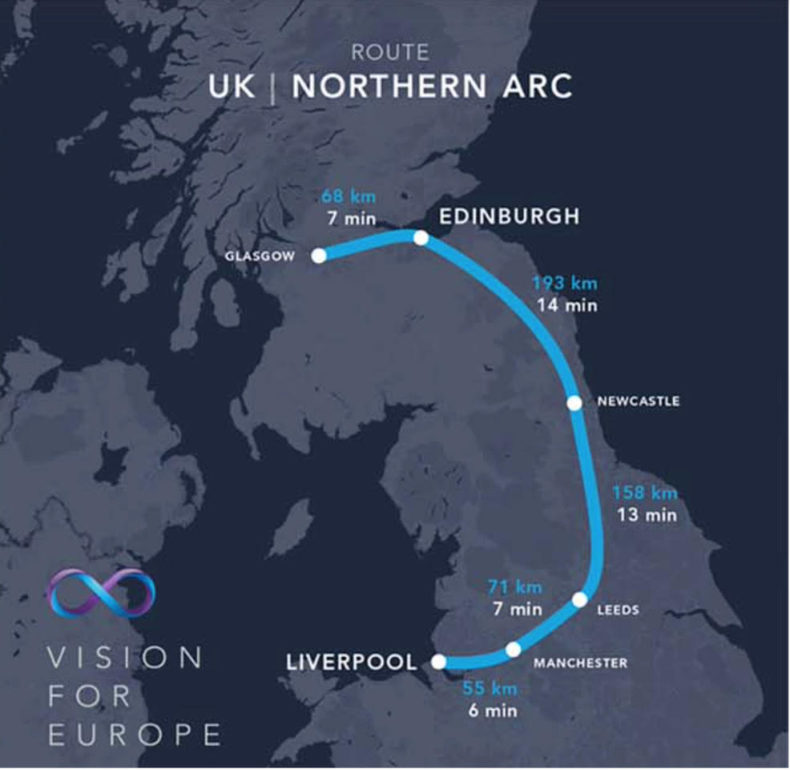In the future, a superfast transport system, now being prototyped, could get you from Leeds to Glasgow in 47 minutes. The north and Scotland would be transformed into a super-city region, with a highly connected population, rivalling London and the South East as the best part of Britain to do business.
It sounds like a pipe dream, and in some ways it literally is. Elon Musk’s ‘Hyperloop’ technology, where pods carrying passengers or freight travel faster than aircraft through a system of vacuum tubes, could make it possible. A Northern Arc has been scoped for Virgin Hyperloop, linking Liverpool, Manchester, Leeds, Newcastle, Edinburgh and Glasgow – a total distance of 545km that could be traversed in under an hour. The first commercial use of this technology for transporting goods is now estimated to be only five years away, people ten.

But now is the moment to think of the possibilities such connectivity could open up. The Covid lockdown has given everyone an insight into remote working and what it might be like to cut geographical ties, congested commutes and high house prices. Businesses are increasingly realising that it’s the connectivity of people, not necessarily locations that matters. With 5G and full-fibre broadband on the way, hub and spoke working could increasingly become the norm, with many of us having mini recording studios in our homes for high quality video interactions combined with periodic attendance at HQ.
But without the right transport infrastructure the impact of this will be much more for areas within reasonable reach of London, accelerating the renaissance of places such as Folkestone and Margate. For the hub and spoke model to work, high tech businesses need access to a large and mobile pool of talent. The commutable greater London population is over 10 million. HS2 to Birmingham increases this further. Other highly successful super-cities around the world are similar sized or bigger. It is neither practical, or desirable from a green perspective, to increase the size of Liverpool, Leeds or Glasgow so dramatically. Instead we should invest in connecting the great cities of Scotland and the north, spreading opportunity throughout the region and making the country as a whole stronger, more prosperous and more united.
Many who disagree with HS2 are much more sympathetic to HS3, the proposed high speed link running across the Pennine belt from Liverpool through Manchester to Leeds. The bit that has been forgotten about is the North East, which sits as close to the Scottish cities as it does the Pennine ones, yet is still only connected to Scotland by a single carriageway road. How much has the lack of functional connectivity between Scotland and its neighbouring northern cities contributed to the willingness for full separation? How different would it be if there was regular free flow of people and culture, as part of a super region?
Intra-regional transport is also of great importance, with second and third tier towns desperately struggling through lack of bus and train routes. De-Beechification will be widely welcomed, as well as giving towns even a fraction of London’s bus service. One advantage of the Hyperloop is that it can easily be integrated with other forms of transport. But the actual technology you use is less important than door-to-door convenience. Currently we have only fragmented transport data and archaic road optimization processes. A first step towards realising the superfast vision could be to create a test bed leveraging the electric vehicles work at Sunderland, the National Innovation Centre for Data in Newcastle and Hitachi rail in Darlington – an apt location given the birth of railways, which provided key stimulus to the Industrial Revolution, occurred there.
But connecting smaller towns to the closest big city does not, in itself, create jobs – you need the infrastructure and the innovators. There is a chicken and egg element here. Immediate steps such as zero rating Entrepreneurs Relief, increasing R&D tax credit rates or other such R&D incentives, specifically in low GVA areas, would help the chicken lay some eggs.
The next question is how to pay for it. Accelerating a northern super-city build ahead of HS2 would be one approach. There is precedent here. The M6 Preston section was the first motorway. Much of rail costs now relate to land acquisition, which is far cheaper in the north. Could a private sector development corporation lead the build, paid for by Land Value Capture, as Rory Sutherland has proposed? Government provides the regulatory framework, creates the incentives and outline routes, linking to the Freeport and Enterprise Zone areas, then leaves details and implementation to others. R&D spending is also very unevenly spread across the country, with NESTA’s The Missing 4 Billion report estimating UK regions have missed out to the tune of £4bn each year, which could have leveraged a further £8bn from the private sector.
Biotech entrepreneur Dr Andy Richards, who knows a thing or two about levelling up, having been one of the driving forces that turned Cambridge and the surrounding area from a sleepy backwater into a high-tech economic powerhouse dubbed ‘silicon fen’ has said “an innovation location is a place that is low risk to locate your family to undertake a high risk job.” It’s easy to see how this applies to the South East – you could set up a business almost anywhere in the Cambridge-Oxford-London ‘golden triangle’ and have access to a pool of highly skilled people and desirable places to live.
Compare this to the challenge facing the spin out of a regional university, compounded by the need to also find employment for the spouse, who may well be in a different specialism which has no activity at all in that location, in contrast to the enormous opportunity reach in the South East. Once social ties are formed and children are at school, the barriers to move outside of the area increase further. For long distance moves, these factors are far greater barriers than stamp duty, although this no doubt contributes.
Building back better by creating a highly connected super-city region, whether with conventional rails, magnets or vacuums, will overcome this and fire up the north and Scotland in just the same way as for the South East – if we have the vision we can do this.
Click here to subscribe to our daily briefing – the best pieces from CapX and across the web.
CapX depends on the generosity of its readers. If you value what we do, please consider making a donation.


